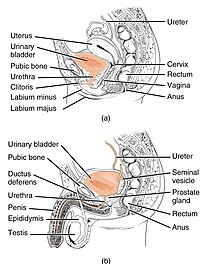
Photo from wikipedia
To describe the clinical response and side effects of radiofrequency treatment in patients with urinary incontinence after radical prostatectomy. This is a phase 1 clinical trial with 10 men up… Click to show full abstract
To describe the clinical response and side effects of radiofrequency treatment in patients with urinary incontinence after radical prostatectomy. This is a phase 1 clinical trial with 10 men up to 65 years of age who had urinary incontinence after radical prostatectomy, post void residual volume < 50 ml verified by ultrasonography, pad test ≥ 1 g, and PSA < 0.2 ng/ml. pad test and self-administered questionnaires were used to assess clinical response. Scales were used to measure treatment satisfaction and improvement in symptoms. Participants underwent five sessions of 2 min of non-ablative endoanal radiofrequency (41 °C). The evaluated co-primary endpoints were urinary incontinence volume and urinary symptoms, analyzed by the Wilcoxon nonparametric test; residual volume, and self-reports to assess safety. The participants’ mean age was 57.5 ± 4.9. The initial pad test score was 6.5 g (1.7–50.0) with a final score of 2.0 g (0.0–9.0) (p < 0.01). Ultrasonography showed no alteration of residual volume. A decrease of urinary loss was found in nine patients, three of them showed a complete resolution of urinary loss. A decrease in irritative micturition symptoms was found as well, but no improvement in the quality of life was shown. Regarding treatment satisfaction, two patients were neutral, six satisfied, and two very satisfied. Limitations included pain while the endoanal electrode was inserted. Four patients indicated pain during treatment, but overall results were positive. The reduction of urinary loss and irritative micturition symptoms increased patients’ satisfaction scores, without improving their perception of quality of life.
Journal Title: Lasers in Medical Science
Year Published: 2019
Link to full text (if available)
Share on Social Media: Sign Up to like & get
recommendations!